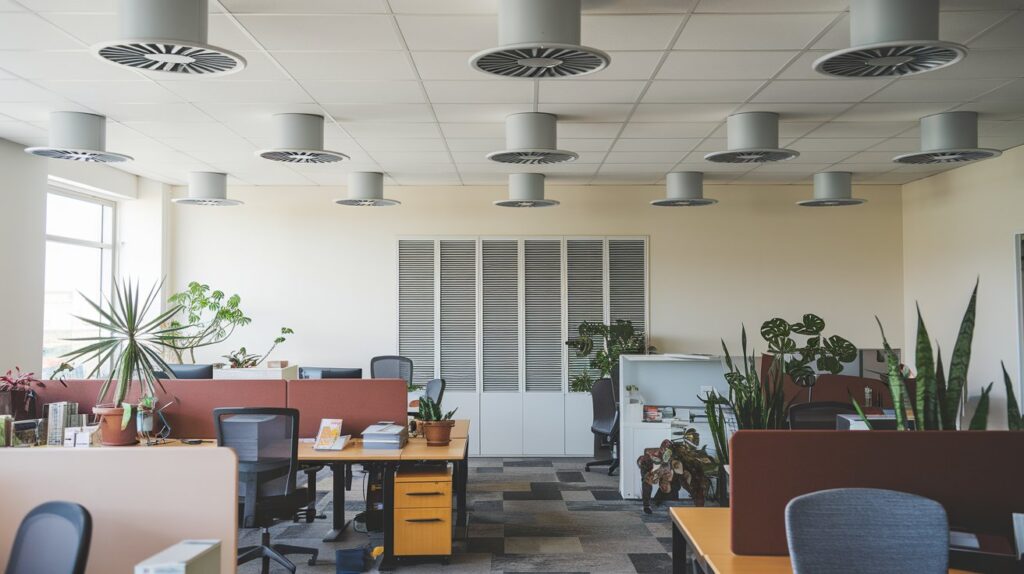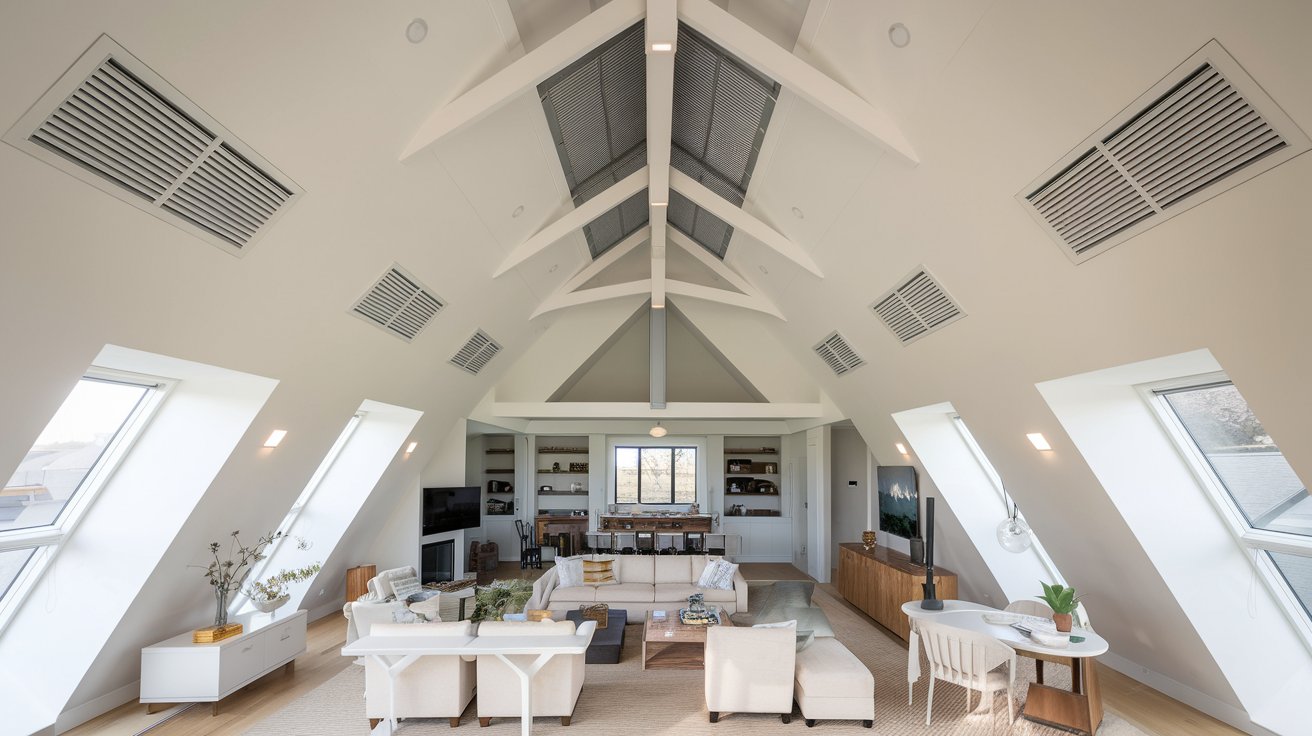A ventilation system is like your building’s breathing machine. It helps move fresh air in and push dirty air out. Whether it’s your house, office, or factory, a ventilation system keeps the air clean and safe. Without it, air can get stuffy, full of dust, or even harmful gases. This can make you feel tired, sick, or just uncomfortable. A good ventilation system doesn’t just make you feel better—it helps your building stay healthy too. Mold, moisture, and bad smells won’t stand a chance if your air is moving the right way.
The ventilation system also helps save energy and money. If your system is set up the right way, it can keep your home cool in summer and warm in winter, without working too hard. That means your heating or cooling machine doesn’t have to use extra power. And the best part? You get better air and a smaller energy bill. There are different kinds of ventilation systems like natural, exhaust, supply, and balanced ones. Each one works best in different weather or building types. Picking the right one is super important. In this blog, we’ll walk you through all the cool things a ventilation system can do, and how to choose one that fits your place just right.
hat Is a Ventilation System and Why Does Your Place Need One?
A ventilation system is a setup that helps fresh air come into your home or building and pushes dirty air out. It’s like giving your space a way to breathe. Every place where people live, work, or play needs clean air to stay healthy and happy. Without a good ventilation system, indoor air can get full of dust, moisture, smells, or even harmful gases. This can make people feel tired, get allergies, or even sick. Ventilation helps to stop mold and keeps air from getting too dry or too wet. It’s also super helpful in places like kitchens, bathrooms, and factories where strong smells or fumes build up. A good ventilation system makes air safe, fresh, and comfortable every day.
How a Ventilation System Keeps Your Air Clean and Fresh
A ventilation system works by moving air around your space. It pulls out the dirty, used air and brings in clean air from outside. This keeps the air inside your home or office fresh and healthy. It removes things like smoke, dust, bad smells, and even germs in the air. When air stays stuck in a room too long, it can make people feel sleepy, sweaty, or sick. But when the air moves the right way, everyone feels better. A good system also helps balance the temperature and keeps humidity under control. So your room won’t feel too wet or too dry. Breathing in clean air helps you stay focused, sleep better, and even feel happier. That’s why fresh air matters a lot.
Different Types of Ventilation Systems and How They Work
There are four main types of ventilation systems: natural, exhaust, supply, and balanced. Natural ventilation uses windows and vents to let air in and out on its own. Exhaust systems pull out dirty air from rooms like bathrooms or kitchens. They create a little vacuum so fresh air sneaks in from outside. Supply systems use fans to push fresh air in, helping reduce stuffiness. Balanced systems are the best of both—they pull in clean air and push out bad air at the same time. Some homes and buildings also use energy recovery systems that save energy while moving air. Each system works differently, so the best one depends on where you live, how big your space is, and what kind of air you need.
Which Ventilation System Is Best for Homes and Which for Offices?
For homes, the best ventilation system depends on your weather and house size. In small homes, a simple exhaust fan might work. For bigger houses, balanced systems are better because they move air in and out evenly. Homes in hot places can use supply systems to keep air fresh and cool. In colder places, energy-saving systems like heat recovery ventilation help save money. Offices usually need stronger systems since more people share the same air. Balanced systems work great in offices too because they control air pressure and keep air quality good. In spaces like factories or kitchens, exhaust systems are needed to get rid of fumes. Always choose a system that fits your space and helps everyone breathe better.

How to Know If Your Ventilation System Is Doing a Good Job
You can tell your ventilation system is working well if the air in your room feels fresh, not stuffy. If windows don’t fog up, there’s no musty smell, and you feel comfortable, that’s a good sign. A strong system also helps with allergies by moving dust and pollen out. If your house feels damp or smells bad after cooking or showering, your system might not be working right. You should also check if fans are running quietly and filters are clean. High energy bills can be a clue too—it may mean the system is struggling. Look around vents and see if air is moving. If something seems off, it might be time for a check-up or cleaning.
Common Problems With Poor Ventilation (And How to Fix Them)
When a ventilation system isn’t working properly, problems can pop up fast. You might notice mold on your walls, water on your windows, or bad smells that won’t go away. People inside might get headaches, allergies, or feel extra tired. These issues happen because stale air and moisture are stuck indoors. The fix? First, clean or replace any dirty filters. Next, check if vents are blocked or broken. If fans are noisy or weak, they may need to be repaired. Adding window vents or using a dehumidifier can also help. In some cases, you may need a better or new system. Getting help from a pro makes sure your space gets clean air again quickly and safely.
Easy Tips to Keep Your Ventilation System Working Great
Taking care of your ventilation system doesn’t have to be hard. First, clean or replace filters every few months. Dust and dirt can block airflow fast. Make sure vents aren’t blocked by furniture or curtains. Open windows now and then to help air move, especially when cooking or cleaning. Check fans in your kitchen and bathroom—if they’re loud or weak, clean them. Keep an eye on moisture levels, and use a small fan or dehumidifier if rooms feel damp. Have your whole system looked at once a year by a pro to make sure it’s running right. A little care goes a long way to keeping your air clean, your system happy, and your bills low.
Ventilation System vs. Air Conditioner: What’s the Difference?
A ventilation system and an air conditioner are not the same, even though both help with indoor comfort. A ventilation system moves air—it brings in fresh air and pushes out stale air. It helps with air quality, smell, and moisture. An air conditioner, on the other hand, cools the air but doesn’t always bring in fresh air. It recycles the same air to lower the temperature. That means you can still have dirty air even if the room feels cold. The best setup is to use both: a ventilation system to keep air fresh, and an air conditioner to control the heat. Together, they make your space more comfy, clean, and healthy for everyone inside.
When Should You Call a Pro to Check Your Ventilation System?
If your rooms feel stuffy, or if there’s mold or extra dust around, it might be time to call a ventilation expert. A professional can check the fans, vents, and filters to see if anything is broken or dirty. You should also call a pro if your system is old or hasn’t been checked in over a year. Strange smells, high energy bills, or noisy fans are other signs something’s wrong. Don’t wait too long—bad air can make people sick, damage your home, or waste your money. A quick inspection can find problems early and fix them before they get worse. Keeping your system in good shape means clean air and peace of mind.
Smart Upgrades for Your Ventilation System That Save Money
Upgrading your ventilation system doesn’t have to cost a lot—and it can save money over time. One smart upgrade is switching to an energy recovery ventilator (ERV), which reuses heat from outgoing air. It keeps your space comfy without using extra power. Another tip is installing automatic timers or smart controls, so your system runs only when needed. You can also add better filters that last longer and catch more dust. If your vents or fans are old, replacing them with newer, energy-saving models can lower your bills. Regular maintenance is an easy upgrade too! It keeps your system running smoothly and avoids big repair costs. Small changes now can bring big savings later.
Conclusion
A good ventilation system is very important to keep the air in your home or office fresh and healthy. It helps bring in clean air and push out bad air so everyone can breathe easier and feel better. Whether you use natural ventilation or a fancy system, the goal is the same — clean, safe air for you and your family or coworkers.
Taking care of your ventilation system by cleaning and checking it often will help it work well for a long time. If you ever notice problems, calling a pro is a smart idea. Fresh air makes a big difference in how happy and healthy we feel every day!
FAQs
A: It brings fresh air in and pushes stale air out to keep the air clean and healthy.
A: Check and clean filters every 3 to 6 months to keep it working well.
A: Yes, some systems reuse heat to save energy and lower bills.
A: Bad smells, mold, noisy fans, or high energy bills mean it might need help.
A: They do different jobs — ventilation cleans air, and air conditioning cools it. Using both is best.

